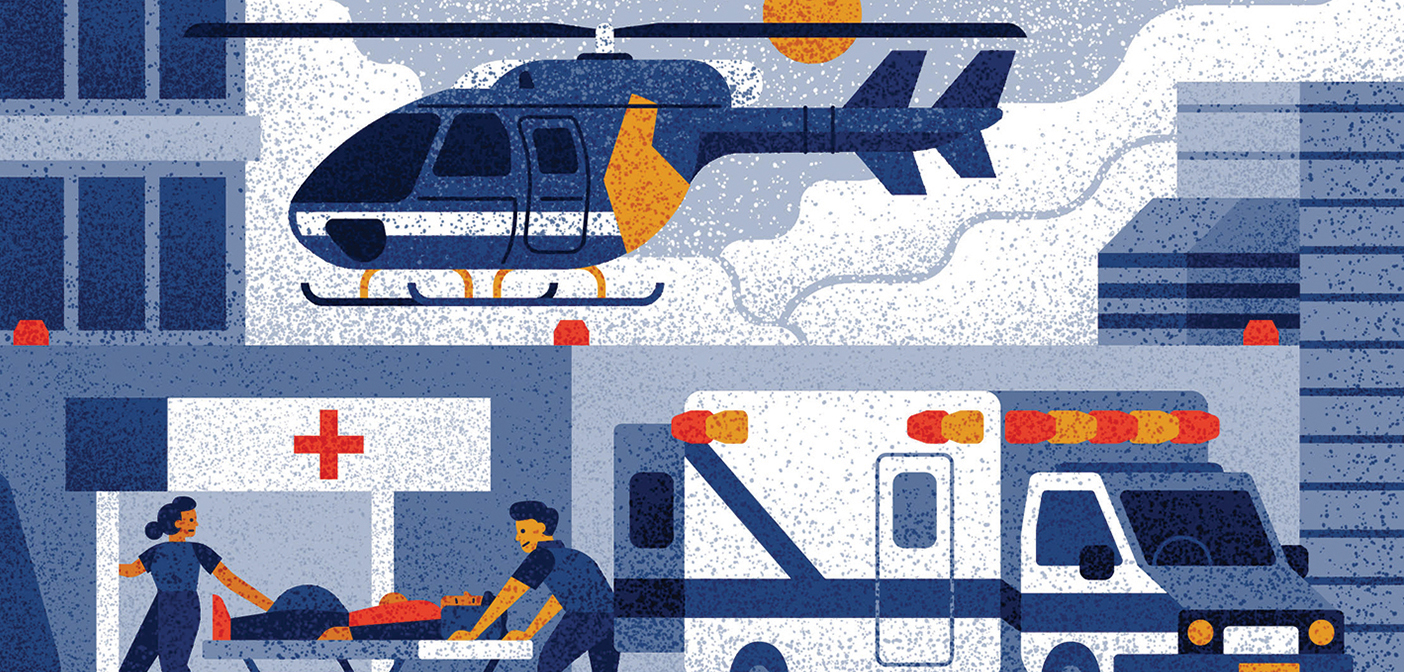By Ashley Festa
Lifeline marks 25 years of air and ground emergency transport by doing what it does best
The helicopters and ambulances might grab more attention, but sometimes the toughest transports are between departments inside the Johns Hopkins Hospital. And that’s what Lifeline critical care transport nurses love about the job: Every day brings new challenges—sometimes hair-raising, never dull.
“When you show up, you never know what the situation is going to be,” explains Meg Dandy, RN, a Lifeline flight nurse for about a year.
Eric Leslie, RN, worked as a Lifeline flight nurse for 10 years before moving to ground and in-house calls. (He joined in 2002.) He recalls one patient, a woman in pre-term labor with triplets, who needed to be airlifted to Johns Hopkins because her primary hospital down on the Eastern Shore didn’t have a neonatal intensive care unit. “We had two providers and potentially four patients,” says Leslie. “We just had to prepare for the worst and hope for the best.”
“We see some of the sickest patients, some of the weirdest cases.”
–Christina Cooper, RN
This year, Lifeline celebrates its 25th anniversary and now serves more than 22,000 patients annually. Lifeline has a special volunteer team that handles communicable diseases, such as Ebola, and Lifeline nurses also handle noncommunicable diseases that most hospitals never encounter.
“We see some of the sickest patients, some of the weirdest cases,” says Christina Cooper, RN, a ground transport nurse for more than three years. “I’ve seen mad cow three times this year. Brain-eating amoebas are very rare, but I’ve seen it twice in two months.”
Calls range from high-risk pregnancies to cardiac or neurological emergencies. Nurses have numerous certifications to treat “every body system that needs any type of intervention,” Cooper says. Flight training involves knowledge of physiology at elevation, gas laws, and how these affect monitoring a patient.
“Flight is more challenging because of logistics: the danger of loading a patient with rotors spinning and the more compact environment,” explains Shawn Trautman, RN, a Lifeline nurse for about three years. “Out-of-the-hospital time is quicker, so it’s easier than ground transport in that way. A two- to three-hour ground transport can be 30 to 45 minutes in flight.”
While in-house transports might get less glory, they’re no less critical. “When transports are done by people who don’t do it all the time, they don’t think to look for things like the patient’s breathing tube getting dislodged,” Dandy says. “When you’re moving patients from one structure or bed to another, that’s when things get pulled out.”
Every transport is unique and meaningful, even if it isn’t about saving a life. Leslie remembers his experience transporting a hospice patient from the Johns Hopkins intensive care unit back to his home.
“He wanted to die at home,” Leslie recalls. “It was a beautiful day. His family was there, and he wanted his dog in the stretcher with him. He lived by the water, so we took him to the river and let him sit outside for a while before we took him into the house.”
“It’s part of the job that is overlooked a bit, but it’s an important aspect of what we do. We were doing what this person wanted, and it kind of gave you a good feeling to be able to provide that.”
He adds, “One of the reasons we’re successful is the passion my co-workers have for making sure the patients come first. I look back and see I really have made a difference in people’s lives, and it makes you feel good.”
Interested in reading more?

